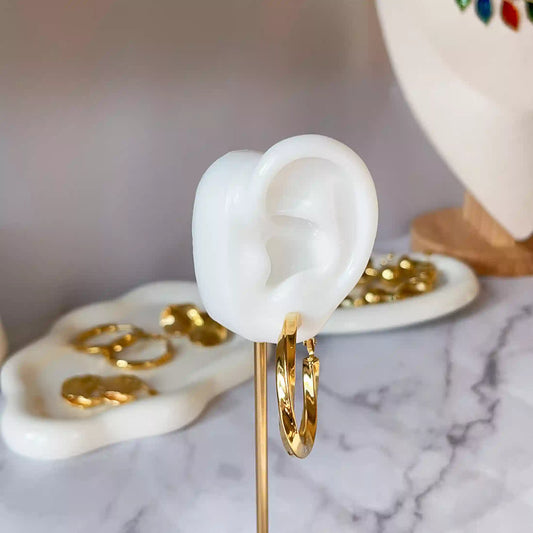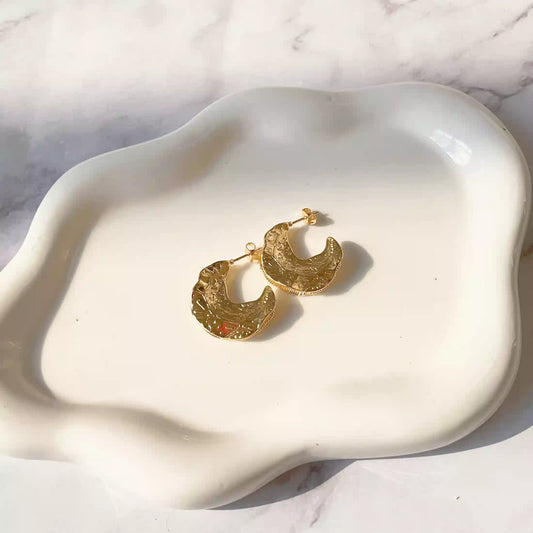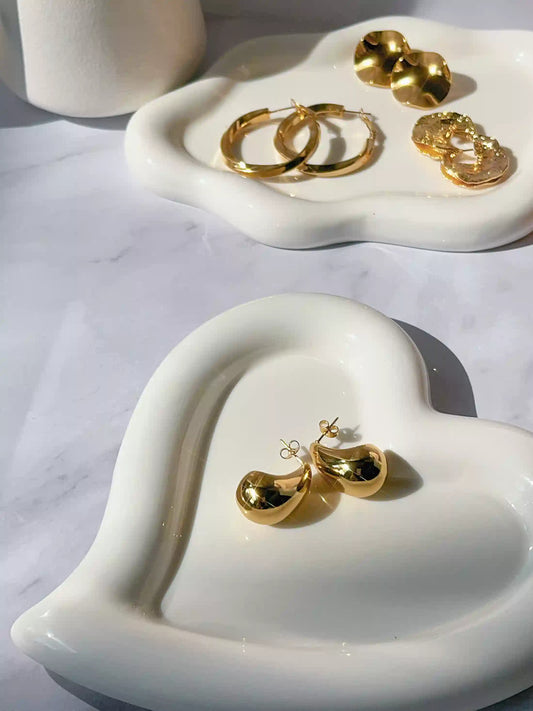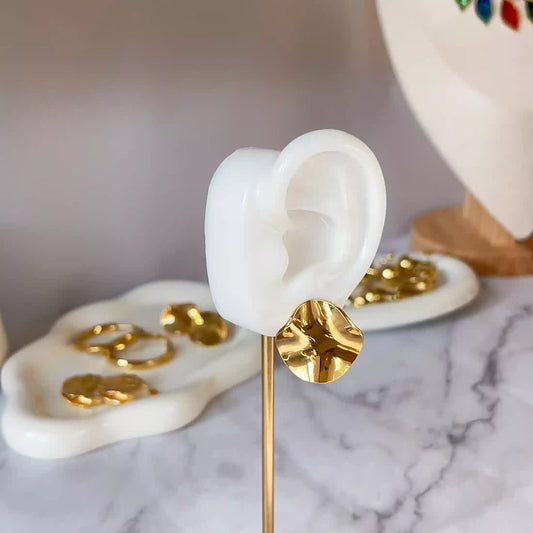Gold plating offers an economically savvy option for purchasing jewelry, providing a look and style similar to gold but without the hefty price tag, making it ideal for everyday wear.
Gold plating comes in various quality levels, largely dependent on the thickness and purity of the gold coating, the base metal used for the piece, and the quality of the craftsmanship. Once gold-plated, it's nearly impossible to distinguish with the naked eye whether the jewelry is real gold or gold-plated.
Like all things, choosing gold-plated jewelry has its pros and cons. Common issues include loss of shine and fading.
Today, Unephemeral present a few nuggets of knowledge about gold plating, helping you decide whether it's worth the purchase.

1. What is Gold Plating?
Gold plating is a process that involves bonding a thin layer of gold onto a base metal. Electroplating is a common technique in the jewelry industry. The process was invented by Italian chemist Luigi Brugnatelli in 1805, where he first plated a thin layer of gold onto silver.
Gold plating is often used in fashion jewelry or to emulate more expensive pieces. It is nearly impossible to distinguish between expensive gold jewelry and inexpensive gold-plated replicas. One may be 18K gold-plated, while the other is pure 18K gold, with a significant price difference, yet the visual distinction is challenging to discern.
2. How is the Gold Plating Process Conducted?
Electroplating jewelry with gold is a straightforward yet multi-step process. The piece of jewelry must be thoroughly cleaned, removing all contaminants, as this is crucial for proper bonding of the gold layer.
Next, an extremely thin layer of high-quality nickel is plated onto the base metal. This step aims to protect the gold layer from the influence of the base metal. As we'll discuss shortly, these metals can seep into the gold layer. The nickel layer also shields against cheap metal impurities in the liquid used for the electroplating process.
Finally, the jewelry is immersed in a container with melted gold, allowing the gold to fuse onto the base metal. Once the gold electroplating reaches the desired thickness, the piece is considered complete.
3. Which Metals Can Be Gold Plated?
Gold plating can be applied to most metals, including nickel, brass, stainless steel, silver, and copper. Even modern industrial metals like tungsten and titanium are often subjected to gold plating. Among these, silver and copper are the most commonly used. Unephemeral typically uses copper as the base metal.
4. Is Gold Plating Real Gold?
Yes, gold plating involves real gold, but due to the minimal amount used, the resulting jewelry cannot carry the same value as solid gold.
The gold used in plating is the same as pure gold. The minimum purity is typically 10K, and the highest is 24K gold. When it comes to gold plating, the primary distinction between these types of gold is the color they produce, not their value. The higher the purity of the gold, the more it resembles the color of pure gold. However, due to the small amount of gold used, the value doesn't vary significantly regardless of purity.
5. How Thick Should Gold Plating Be?
Gold plating thickness typically ranges between 0.17 and 2.5 micrometers.
The ideal thickness for gold plating is around 0.5 to 1.0 micrometers. While this may sound like a thin layer, it is more than sufficient for everyday-wear jewelry.
A gold layer electroplated with a thickness of 2.5 micrometers is considered quite thick and is termed heavy gold plating. However, even with such a thickness of gold plating, the actual amount of gold remains minimal, and the primary benefit is an extended lifespan with a thicker coating.
6. Is Gold-Plated Jewelry Worth Recycling?
Due to the thin layer of gold on most jewelry, it is challenging to recover any significant portion. Attempting to extract gold from electroplated jewelry is often not worthwhile for gold refineries, as the profit margins are very low.
As mentioned earlier, gold-plated items contain very little actual gold. Overall, the total amount of gold is negligible and doesn't add much to the value of the piece. Gold-plated items usually have minimal resale value; their worth is not measured in terms of the gold content. For everyday-wear jewelry, Unephemeral suggests that gold plating remains a more economical choice.
7. Does Gold Plating Tarnish or Lose Shine?
Gold plating can lose its shine and brightness over time with usage. This is a common occurrence, regardless of the quality of the piece. However, many wonder why gold-plated jewelry loses its luster. After all, isn't gold an inert metal, resistant to rust and corrosion?
The issue of losing shine is typically not with the plating itself but with the corrosion and oxidation of the base metal. Over time, molecules from the base metal can eventually migrate into the gold layer, affecting its appearance. If the gold plating is very thin, it may discolor and start to look like it's losing its shine.
As mentioned earlier, if the jewelry is first plated with nickel, this loss can be prevented, shielding against the impact of base metals on the appearance of gold.
8. How Long Does Gold Plating Last?
Gold plating will wear off and lose its shine with use, but generally, if cared for properly, electroplating can last for many years.
The most ideal approach is to replate when necessary. This depends on the thickness of the plating, the color of the base metal, the color of the quality workpiece, and the degree of wear on the jewelry.
9. How Do I Care for and Repair Gold-Plated Jewelry?
-
Keep gold-plated jewelry away from chemicals, oils, and cosmetics. Putting on jewelry after applying makeup is a recommended step.
-
Remove gold-plated jewelry while doing household chores, as chemicals in soaps, detergents, and cleaners can affect the electroplating.
-
Maintain clean hands when handling gold-plated items, so try to wash your hands thoroughly before putting on or taking off jewelry.
-
Avoid exposing gold-plated jewelry to chlorinated water or saltwater. This means taking off jewelry before swimming in pools, hot tubs, or the sea.
-
Body oils and sweat can affect gold plating. To address this issue, regularly wipe the jewelry.
-
Regularly cleaning gold-plated jewelry is crucial for extending its lifespan. Use mild liquid soap or specialized jewelry cleaning solution with warm water. Avoid any abrasive chemicals or abrasive cleaners. Avoid brushing or rubbing gold-plated jewelry, as this may cause it to peel, exposing the underlying metal.
10. Is Gold Plating Hypoallergenic?
This depends on the thickness of the gold and whether it contains allergenic metals like nickel, zinc, and cobalt.
Generally, gold plating is not considered hypoallergenic because of the underlying layer of nickel. When the gold plating wears off or peels, the nickel in the jewelry may come into contact with your skin, triggering a reaction.
If you have metal allergies, it's advisable to check the metal alloy content before making a purchase to avoid allergic reactions.









